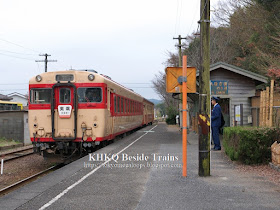Last month, an Isumi Railway train derailed in Chiba Prefecture due to poor track maintenance. The railway has been closed for more than a month, raising concerns about the safety and the future of the railway, but local governments would not allow it just to be abandoned.
NHK reported that a westbound train formed of two coaches derailed between Kuniyoshi and Kazusa-Nakagawa stations at around 8:10 am on 4th October. There were 104 passengers (mostly high school students) and a driver onboard, but nobody injured. The line has been closed since then and replaced by bus. The Japan Transport Safety Board has carried out an investigation and its report is expected to be published within weeks.
According to Asahi Shimbun, decayed sleepers made of wood could not fix the rail. The train company acknowledged the situation and thus planned repair work that would take place in late November, but the accident happened before that. The company initially envisaged reopening the line within four weeks, but according to Nikkei, too many decayed sleepers were found on the entire line so that it would not reopen until March 2025.
Isumi Railway is a 26.8 km (16.6 miles) long railway in Chiba Prefecture, roughly 60 km (38 miles) southeast of Tokyo. It opened in 1930 as Kihara Line, and renamed Isumi Line when the entire line was transferred from JR East to Isumi Railway in 1988. The line and the company have been funded almost fully by local governments since then.
It was anticipated that there would be very low ridership even before the line was constructed, as the area has always been sparsely populated. The Transport Ministry and local governments discussed about "alternative transport" (i.e. road transport) several times since the 1980s. The latest proposal for the permanent closure was made in 2007, but increasing service frequency, building a new station and selling naming rights have succeeded so that the proposal was subsequently withdrawn. In the 2010s, then-president of the company and a railway enthusiast Akira Torizuka introduced old diesel trains, attracting many other railfans that contributed to not only the train operator itself but also the local economy. Isumi Railway looked somewhat a successful rural railway even amid the decline in demand triggered by the depopulation.
However, the company has spent little on track maintenance. The above photograph clearly shows how deteriorated the rail is (click the photo for a larger image). Despite the low speed of just 30-50 km/h (20-30 mph), trains have always been bumpy. The company concentrated on replacing old bus-like rolling stock 200 series, but it has not invested enough in other part of the railway. When there was an almost identical derailment in 2013, the company has decided to replace wooden sleepers with concrete ones, but it has been advancing at a glacial pace due to financial difficulties. There are many rural railways across the country which train operators have been struggling to maintain, but Isumi Railway seems to have been particularly unsuccessful in securing track safety.
Even so, there is also a sign of hope. The Nikkei article refers to local governments willing to support the company, suggesting that they consider keeping the railway open as essential for local communities. The cost of the work could be substantial even if not all wooden sleepers are replaced with concrete ones at once, but they have been positively discussing about subsidies. It implies taxpayers in the area would agree with not just the expenditure this time but also funding other costs that may be necessary in the near future.





No comments:
Post a Comment